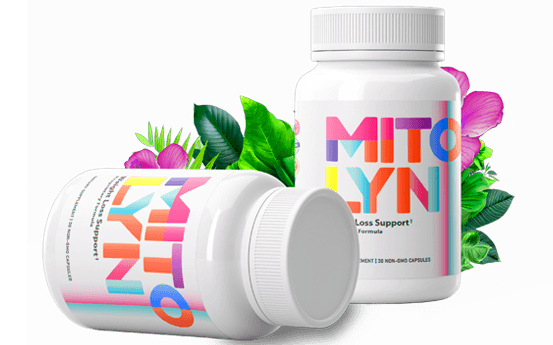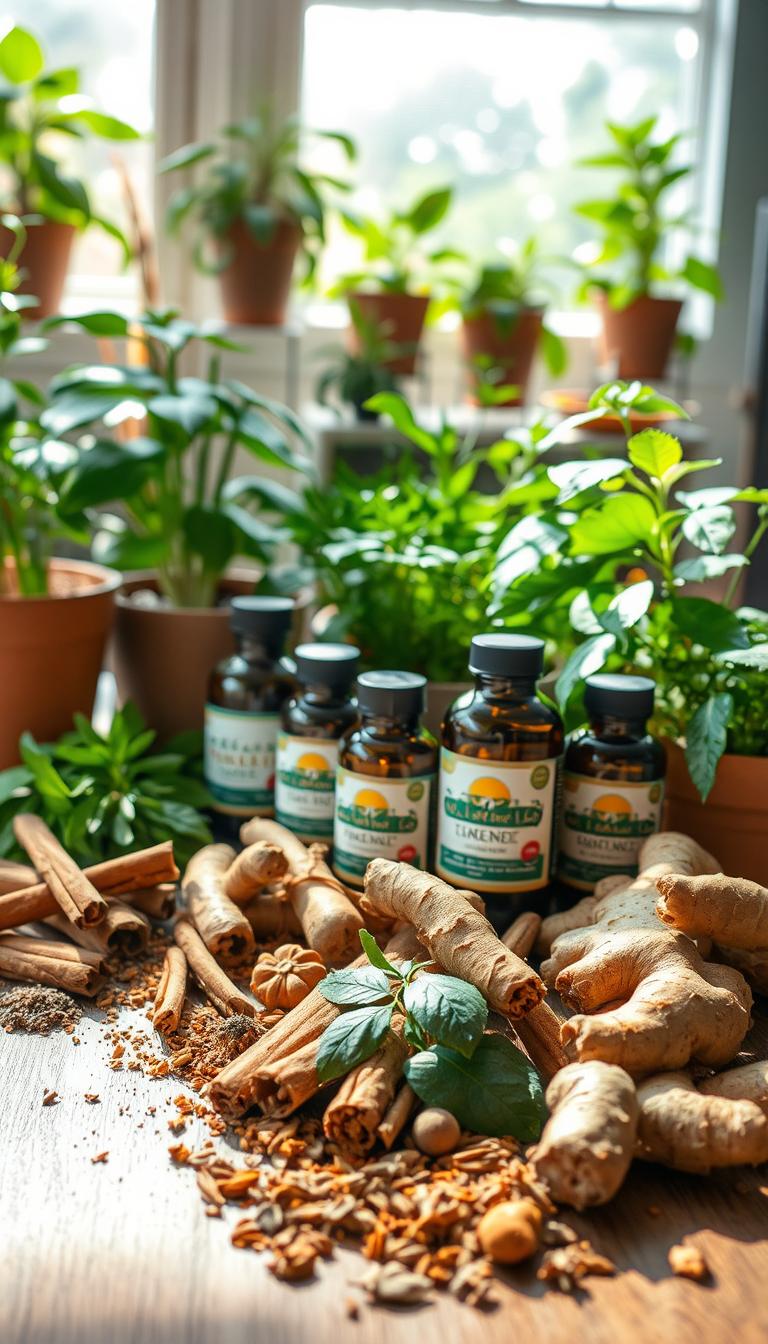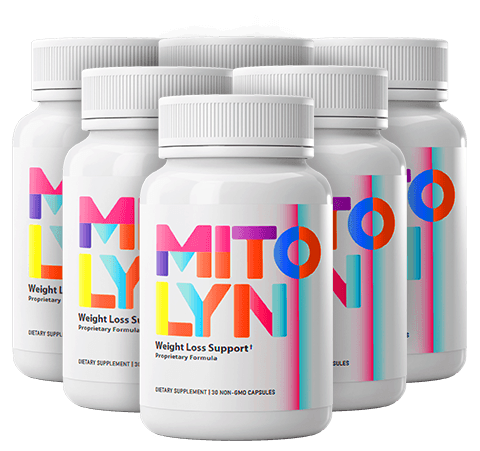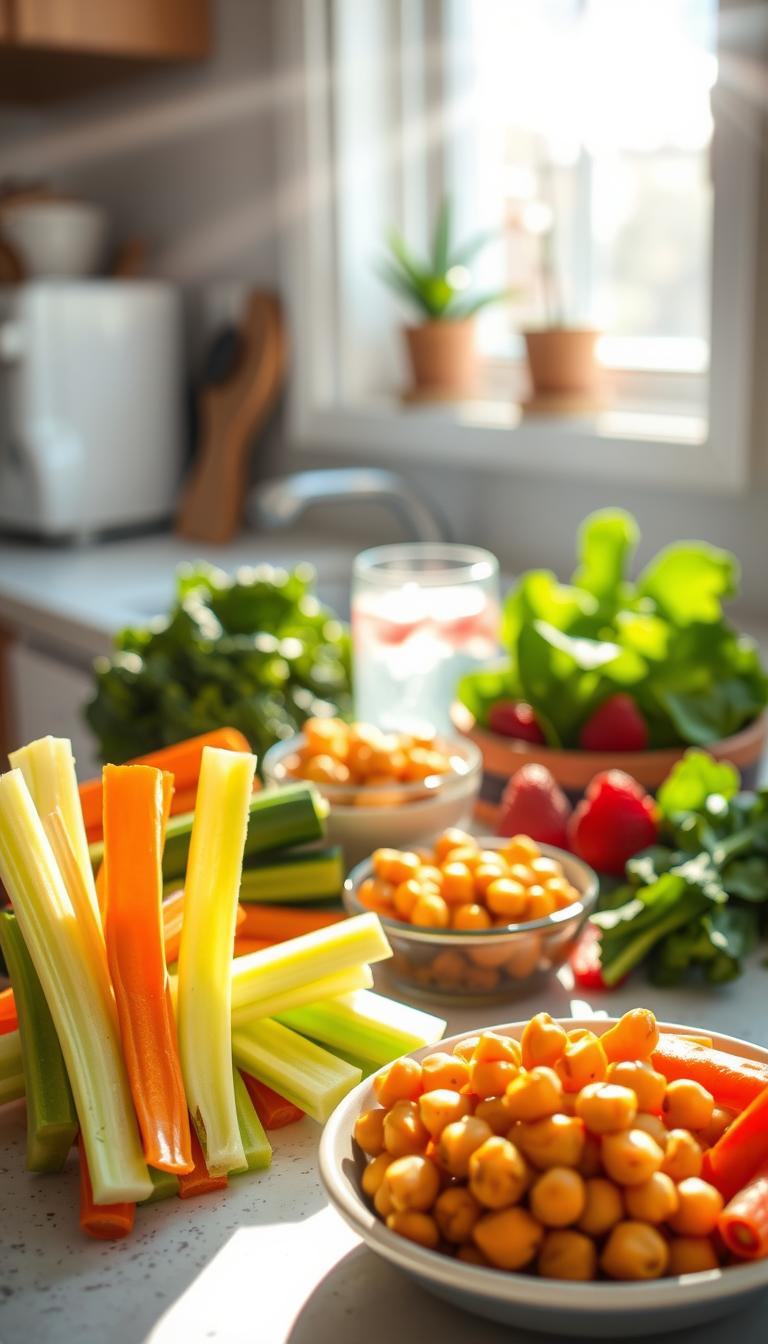
I used to think managing my blood sugar was hard. I thought it needed special supplements or strict diets. But then I found something surprising in my kitchen—common spices like ginger, cinnamon, and turmeric. Could these everyday items really help? Science says yes.
Studies show ginger’s powerful compounds, like gingerol, can balance blood sugar. They do this by reducing inflammation and making insulin work better. I started using these spices and found they could help control blood sugar.
A 2024 review in Nutrients found ginger supplements lower blood sugar and A1C levels in type 2 diabetes. Even a small amount, like ½ teaspoon of ground ginger daily, can help. Cinnamon and turmeric also show promise. But how do they work?
These spices aren’t just trends. They’re backed by research and easy to add to your favorite meals.
Key Takeaways
- Ginger’s gingerol may reduce inflammation and improve insulin resistance.
- Studies show ginger lowers fasting blood sugar and A1C in type 2 diabetes.
- Just ½ teaspoon of ground ginger daily can make a difference.
- Pair spices with a plant-focused diet, exercise, and sleep for best results.
- Cinnamon and turmeric also improve insulin sensitivity and digestion.
- Turmeric’s curcumin works better with fat or black pepper.
My Journey to Finding Natural Blood Sugar Solutions
Managing blood sugar levels became a personal mission for me. I grew wary of relying solely on medications. My search for a natural remedy for blood sugar started when I noticed synthetic treatments left me feeling drained. That’s when I turned to the kitchen for answers.
Why I Started Looking for Natural Alternatives
Medications worked, but their side effects made me question long-term use. I wanted something safer and more accessible. That’s when I recalled centuries-old remedies tied to spices like cinnamon. My journey began by researching how these everyday ingredients might help.
The Surprising Discovery in My Kitchen Cabinet
“Spices aren’t just for flavor—they’re medicine in small doses.”
Opening my spice rack felt like flipping a new chapter. Cinnamon, turmeric, and ginger stood out. Early research showed cinnamon could mimic insulin activity. A meta-analysis even noted a 3-5% drop in fasting glucose—results comparable to older diabetes drugs. Yet, I needed proof beyond studies.
What Made Me Investigate Further
Seeing cinnamon’s potential, I tested it myself. Adding a half-teaspoon daily to meals led to slight but consistent improvements. Encouraged, I dived deeper, uncovering how spices like cinnamon and fenugreek work. Below compares two cinnamon types:
| Type | Coumarin Content | Best Use |
|---|---|---|
| Cassia | High | Short-term use |
| Ceylon | Low | Long-term consumption |
Combining my experience with data, I learned spices aren’t just trends—they’re a spice for diabetes management with real-world applications. Now I blend them into meals, from smoothies to savory dishes, proving nature’s tools can be both powerful and practical.
Understanding Blood Sugar: Why Balance Matters
Keeping blood sugar levels healthy is crucial to avoid serious health problems. Blood sugar gives your body energy. But, if it’s too high, it can harm your organs and increase disease risk.
My research shows that long-term high blood sugar can lead to prediabetes or type 2 diabetes. This affects over 100 million Americans.
When insulin doesn’t work right, cells can’t take in sugar. This makes insulin resistance. It starts a cycle of high blood sugar and health problems.
Over time, this imbalance can increase the risk of heart disease, kidney damage, and nerve issues.
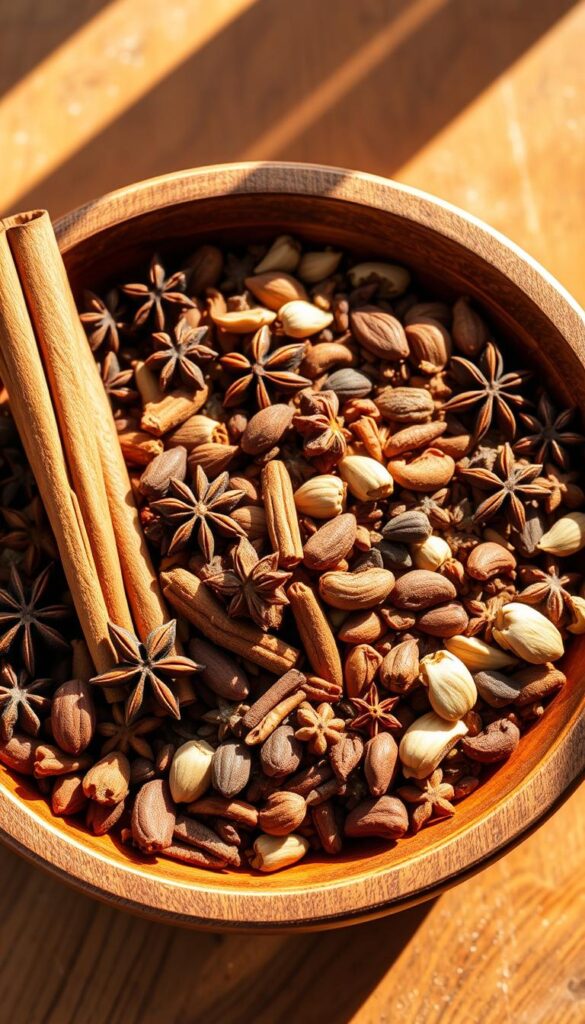
Small daily choices are important. Simple actions like eating mindfully and moving more help. But what about everyday ingredients?
Spices like cinnamon and turmeric have compounds that help control blood sugar. Studies show they may improve insulin function and lower inflammation linked to metabolic issues.
Protecting your health starts with knowing your body’s needs. By focusing on balance, you’re not just avoiding diabetes. You’re also keeping your energy, vitality, and long-term wellness safe. Natural tools like blood sugar control spice can help you stay healthy.
Common Kitchen Spice to Lower Blood Sugar: The Research Behind It
Let’s explore the science behind common kitchen spice to lower blood sugar. Research shows some spices do more than add flavor. They help balance blood sugar levels. Here’s what we found:

| Spice | Active Compounds | Key Benefits |
|---|---|---|
| Cinnamon | Methylhydroxychalcone | Slows carbohydrate digestion; lowers fasting glucose |
| Turmeric | Curcumin | Enhances insulin sensitivity; reduces inflammation |
| Ginger | Gingerol | Improves glucose metabolism; lowers A1C levels |
| Fenugreek | Trigonelline | Slows glucose absorption; lowers post-meal spikes |
“Spices like cinnamon and turmeric offer promising adjuncts to standard diabetes care—but always consult your healthcare team first,” says Dr. Emily Carter, a diabetes specialist.
Studies show how these spices help. For example, spice for regulating glucose levels like cinnamon acts like insulin. It helps cells take in sugar. Turmeric’s curcumin boosts insulin receptors. Gingerol in ginger slows down how carbs are broken down.
A 2024 study in Nutrients found ginger cut fasting blood sugar by 12% in type 2 diabetes patients. Another study in Evidence-Based Complementary and Alternative Medicine showed ginger improved insulin sensitivity by 20%.
Doctors say these spices are helpful but not enough on their own. Always talk to your doctor about using them. They should be part of a bigger plan that includes diet and medicine.
Cinnamon: The Sweet Solution to Blood Sugar Concerns
Cinnamon is more than just a spice. It’s a blood sugar control spice that science supports. I’ve found it works well, especially when I eat mindfully.
“Cinnamon supplementation can lower fasting blood sugar levels, making it a promising adjunct therapy for type 2 diabetes.” – 2024 Meta-Analysis of 24 Trials

Type Matters: Ceylon vs. Cassia
Not all cinnamon is the same. Here’s what you need to know:
| Type | Coumarin Content | Blood Sugar Impact |
|---|---|---|
| Ceylon (True) | Low | Steady improvement in insulin sensitivity |
| Cassia | High | Effective but avoid long-term use |
How Much Cinnamon to Use
Start with a small amount to avoid side effects. Aim for:
- 1/2 to 1 tsp daily in food
- Supplements (check labels for mg per serving)
- Don’t take more than 6 g/day without a doctor’s advice
Easy Ways to Add More Cinnamon
Here are my top ways to add cinnamon:
- Stir it into coffee or tea
- Add it to oatmeal or yogurt
- Season veggies or soups with it
Choose trusted brands like McCormick or Starwest Botanicals to avoid bad stuff. Cinnamon works best with a healthy diet and exercise. It’s a key part of a complete plan for diabetes prevention.
Turmeric: The Golden Spice with Promising Benefits
Turmeric is a strong spice for managing diabetes naturally. It has a compound called curcumin. This compound helps improve insulin sensitivity and lowers inflammation.
A 2012 study showed great results. Prediabetic people who took curcumin for nine months were 16% less likely to get type 2 diabetes. This was compared to those who took a placebo.
“Participants who took curcumin supplements were 16% less likely to develop type 2 diabetes over 9 months.”
But, curcumin isn’t easily absorbed by the body. To make it work better, add:
- Black pepper: It has piperine, which boosts curcumin absorption by 2,000%.
- Healthy fats like coconut oil or olive oil: They help curcumin get absorbed better.
I’ve tried adding turmeric to my meals. It’s great in golden milk, roasted veggies, or scrambled eggs. It adds a nice flavor. Mixing it with black pepper and healthy fats makes it more effective.
Recent studies, like a 2023 meta-analysis, support turmeric’s benefits. It can lower blood sugar and hemoglobin A1C levels in people with type 2 diabetes.

Turmeric isn’t a cure, but it’s a tasty part of a healthy diet. Always talk to a doctor before using it. Your kitchen’s golden spice could be a simple but powerful health tool.
Ginger: Spicing Up Your Blood Sugar Control
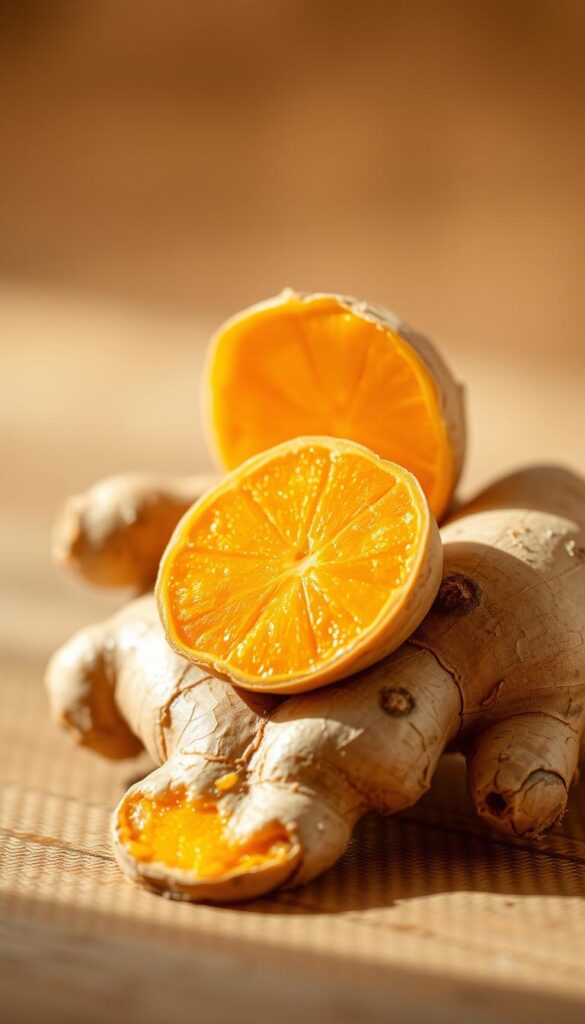
Ginger is more than just a flavor enhancer. It has hidden benefits for blood sugar control. Studies show gingerol, a compound in ginger, can make insulin work better and lower blood sugar.
A 2024 study found ginger supplements helped type 2 diabetes patients. They had lower A1C levels than those who took placebos.
Fresh vs. Dried Ginger: What Works Better
| Form | Benefits | Best Uses |
|---|---|---|
| Fresh | Potent enzymes, higher concentration of active compounds | Smoothies, stir-fries, or fresh tea |
| Dried | Longer shelf life, concentrated flavor | Teas, soups, or spice blends |
My Favorite Ginger Tea Recipe for Blood Sugar Management
- 1-inch fresh ginger root, grated
- 1 cup water
- 1 tsp honey (optional)
Boil the ingredients for 5 minutes. Strain and drink it every day. I’ve seen my blood sugar levels get smoother after drinking this before meals.
The Added Anti-Inflammatory Benefits
Ginger’s anti-inflammatory effects go beyond blood sugar. It may also reduce joint pain and soothe skin conditions like psoriasis. But, always talk to a doctor before taking supplements, especially if you’re on diabetes meds. Ginger can increase the risk of low blood sugar when mixed with insulin or sulfonylureas.
Fenugreek: An Ancient Remedy Worth Revisiting
I’ve always been interested in fenugreek as a natural remedy for blood sugar. It’s a spice for healthy blood sugar levels. Fenugreek has compounds like diosgenin and saponins that help with metabolism. For centuries, Ayurvedic practices used it. Now, studies show it improves insulin sensitivity and glucose metabolism.
How to Prepare Fenugreek Seeds for Maximum Benefit
- Soak seeds overnight to soften texture and reduce bitterness
- Grind dried seeds into a powder for smoothies or curries
- Sprout seeds for 24–48 hours to boost nutrient availability
- Mix with yogurt or salads for easy digestion
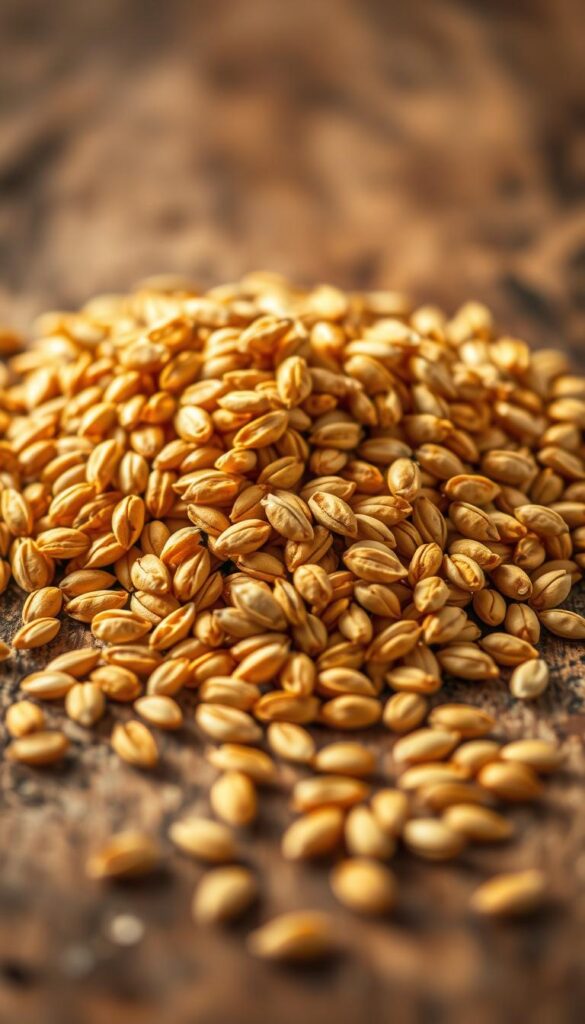
| Aspect | Whole Seeds | Supplements |
|---|---|---|
| Taste | Earthy flavor; requires gradual introduction | Neutral taste in capsules |
| Cost | Bulk seeds are budget-friendly | Pills may cost more |
| Flexibility | Customizable in meals | Standardized dosing |
Whole seeds are rich in fiber (25% dietary fiber). Supplements focus on active compounds like 4-hydroxyisoleucine. Both have antioxidants like quercetin. But, how well your body absorbs them depends on what you prefer. Start with 2–5g of seeds daily. Always talk to a doctor if you’re on diabetes medication.
My Daily Routine: How I Use These Spices for Blood Sugar Management
Every morning, I add spice for regulating glucose levels to my coffee. Just half a teaspoon of Ceylon cinnamon does the trick. It’s mild but effective for blood sugar balance. I also mix turmeric into smoothies with berries and almond milk. The warmth of the kitchen spice for blood sugar management goes well with fruit.
Here’s how I spread these ingredients throughout my day:
- Morning: Cinnamon in coffee or oatmeal
- Noon: Turmeric in scrambled eggs or salad dressings
- Evening: Ginger tea with lemon, steeped for 5–7 minutes
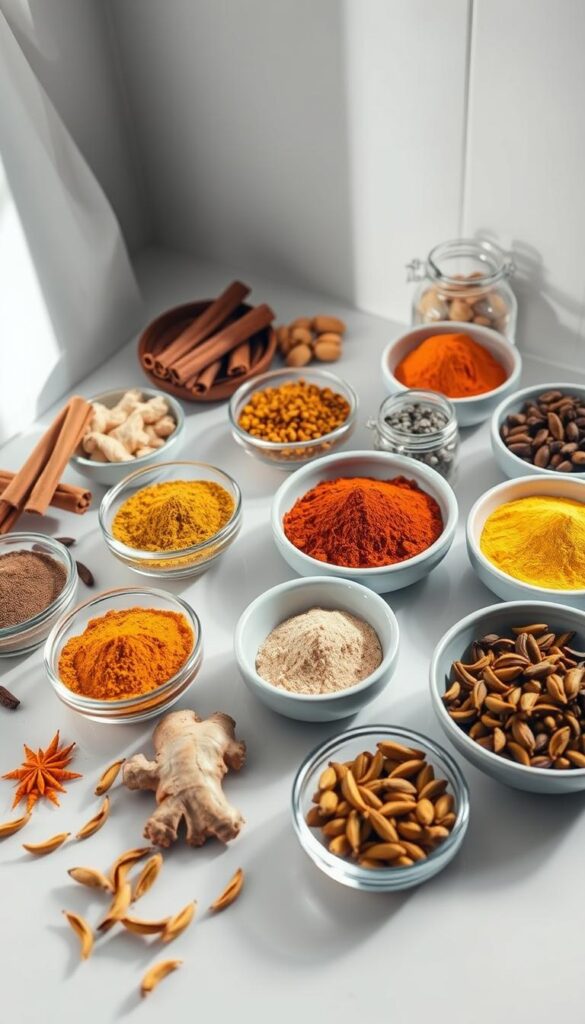
I keep fenugreek seeds in my pantry. I sprinkle them over roasted veggies or mix into yogurt. Consistency is key—my blood sugar trends improved after three months. I track readings weekly and adjust portions if needed.
For example, I use 1–2 tsp of ground cinnamon daily. Studies show it boosts insulin sensitivity. Pairing spices with meals like quinoa bowls or stir-fries makes it easy to stay on track.
Small changes add up! I’ve learned to experiment: turmeric lattes in the afternoon, or a dash of ginger in soups. These simple swaps turn everyday meals into tools for better health. My advice? Start with one spice at a time and build the routine gradually.
Important Precautions When Using Spices for Blood Sugar Control
Spices like cinnamon and turmeric might help with blood sugar. But safety is key. Always put your health first by following these tips. The spice for diabetes prevention journey needs caution.
- Never stop prescribed medications without talking to your doctor. These spices are not a substitute for insulin or diabetes drugs.
- Too much turmeric (over 4 grams daily) can harm your liver. Use only the recommended amounts.
- Essential oils are for smelling, not eating. Many are toxic if swallowed.
Medication Interactions to Watch For
If you take blood thinners like warfarin, talk to your doctor about spice use. Cinnamon and turmeric might change how blood clots. Also, some spices can lower blood pressure. Be careful if you’re on BP medication.
When to Seek Medical Advice
- See your doctor before surgery, pregnancy, or breastfeeding.
- Talk to your healthcare team if you have liver or kidney problems.
- If you take many medications, check for interactions first.
Stop Use Immediately If You Experience:
- Severe stomach pain or vomiting
- Rash or allergic reactions
- Frequent dizziness or fatigue
Always do a skin patch test with new spices or oils. My advice? Start slow and stay informed. Your health is worth the extra effort!
Complementary Lifestyle Changes That Enhance the Effects of These Spices
Using spice for healthy blood sugar levels with good lifestyle choices makes them even better. I’ve noticed how simple changes like walking after meals or sleeping well can help. These changes make the spices more effective.
“Aiming for at least seven hours of sleep per night has been shown to positively impact blood sugar, metabolism, and overall health.” — Micko
Begin with a simple walk of 10–15 minutes after eating to improve insulin sensitivity. Add yoga or deep breathing to lower stress and blood sugar. A 2015 study found pistachios help lower heart disease risk in diabetics. So, enjoy nuts with cinnamon tea.
- Drink turmeric milk before bed to help with sleep and blood sugar.
- Add fenugreek seeds to meals for more fiber—studies show it slows sugar absorption.
- Pair spices with foods high in fiber like oats or leafy greens for better effects.
Regular exercise and eating lots of veggies, whole grains, and lean proteins are key. Even a 2011 almond study shows nuts help type 2 diabetics. So, try cinnamon on almond butter toast for a healthy snack.
Remember, spice for diabetes management works best with a whole approach. Small steps like eating mindfully, moving regularly, and getting good sleep make these spices powerful health allies.
Real Success Stories: How Others Have Benefited
Many readers have shared inspiring stories about how natural remedies for blood sugar changed their health. They talk about the big difference simple changes made. For example, adding a blood sugar lowering spice to their daily routine.
“Since sprinkling cinnamon on my oatmeal daily, my A1C dropped from 6.5 to 5.8. I also walked 30 minutes more each day!”
Here’s how others have succeeded:
- Maria (58, prediabetes): Mixed ½ tsp cinnamon in coffee and tea. Combined with portion control, her fasting glucose dropped from 120 to 95 mg/dL in 3 months.
- David (45, type 2 diabetes): Added turmeric to meals and took fenugreek tea. His doctor noted a 15% improvement in insulin resistance after 6 weeks.
- Emily (32, prevention focus): Used ginger in smoothies and cut refined carbs. Her 2-hour post-meal readings stabilized within weeks.
These stories show that small steps can lead to big changes. While results vary, many found adding a blood sugar lowering spice helped. Always talk to your doctor before trying new supplements.
Conclusion: Embracing the Power of Nature’s Medicine Cabinet
Nature’s remedies like cinnamon, turmeric, ginger, and fenugreek are more than just spices. They help manage blood sugar levels. Cinnamon helps control glucose, and ginger makes insulin work better. Even a little turmeric or fenugreek tea can help.
These common kitchen spice to lower blood sugar work best with exercise and eating right.
My own journey showed me that small steps are important. Adding cinnamon to oatmeal or drinking ginger tea became easy habits. But remember, these spice for diabetes prevention aren’t magic. They need sleep, stress control, and a diet full of veggies and grains.
I’ve seen how moringa leaves or guava tea can help too. But being consistent is crucial. Start with one spice that you like. Try cinnamon in your coffee or turmeric on roasted veggies. Over time, these choices lead to lasting changes.
Nature’s medicine cabinet is full of potential. By using these spices and taking care of your health, you’re in control. Your kitchen is full of tools to help you on your journey, one delicious step at a time.
FAQ
What common kitchen spice can help lower blood sugar?
Kitchen spices like ginger, cinnamon, turmeric, and fenugreek can help with blood sugar. Each spice has special properties that help control glucose levels and manage diabetes.
How do spices like cinnamon and ginger help with blood sugar control?
Spices like cinnamon and ginger improve insulin sensitivity and reduce inflammation. They help slow down carbohydrate digestion. This keeps glucose levels steady after meals.
Are there scientific studies supporting the use of spices for diabetes management?
Yes, many studies have looked into how spices affect blood sugar. They found that ginger and cinnamon can help control blood sugar and improve metabolic health.
How can I incorporate these spices into my daily routine?
You can add these spices to your meals easily. Sprinkle cinnamon on oatmeal, blend ginger into smoothies, or use turmeric in soups and teas. Even a little bit each day can help manage blood sugar.
Are there any precautions I should take when using these spices?
While spices are good, talk to a healthcare professional first. Especially if you’re on diabetes meds. Some spices might affect your meds, so always check before making changes.
Can these spices replace prescribed medications for diabetes?
No, spices should not replace your meds without a doctor’s say-so. They can help your health, but should be part of a bigger plan to manage diabetes.
How do lifestyle changes enhance the effects of these spices?
Regular exercise, stress management, good sleep, and a balanced diet boost the effects of these spices. These changes work together to better manage blood sugar.








